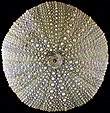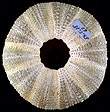The Echinoid Directory
Loxechinus Desor, 1856, p. 136
| Diagnostic Features |
|
|---|---|
| Distribution | Recent; Chile and Peru. |
| Name gender | masculine |
| Type | Echinus albus Molina, 1782, by original designation. |
| Species Included | Only the type species. |
| Classification and/or Status |
|
| Remarks | Easily distinguished from the rather similar Paracentrotus by the more numerous pore-pairs on each ambulacral plate. It closely resembles Strongylocentrotus in test appearance, differing only in that its globiferous pedicellariae have lateral teeth. Its dicyclic apical disc structure distinguishes it from Strongylocentrotus. |



